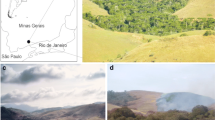Abstract
The 10-year dynamics of the catalase activity of leached chernozem was studied in order to determine the intensity and direction of redox processes in the postpyrogenic ecosystem located in the forest–steppe of the European part of Russia. The results are presented for a study of the formation Pinus sylvestris with the background coordinates of 52°30′39.2″ N, 38°57′30.3″ E and pyrogenic coordinates of 52°30′37.3″ N, 38°57′28″ E of the sites after a forest fire in 2010. The species composition of plants in forest formations was revealed via the laying of test plots with a size of 400 m2 that included ten described counting sites with a size of 1 × 1 m. The tiers were set according to the height of the trees and grass stand. The plant communities were named according to the listing of the established dominants by coverage. The abundance was counted according to O. Drude’s scale. Three phases of pyrogenic formation recovery have been identified: (1) the phase of ruderal phytocenosis (2010–2012), (2) the phase of the transformation of the ruderal phytocenosis (2014–2017), (3) the initial phase of the restoration of the forest phytocenosis (2018–2020). Analysis of the catalase activity of the soil and the structural ecobiomorphological characteristics of the flora gives a view of the temporal aspect of the restoration of the forest ecosystem in the forest–steppe zone after a fire under the conditions of moisture deficit. The absolute values of the regression coefficient of catalase activity in leached chernozem sharply decrease in the studied series of soils, from the background values (0.34) to the pyrogenic (0.26), and increase 10 years after the fire (0.42). Analysis of the catalase activity and flora structure reflect the 10-year dynamics of the formation of a forest ecosystem with pyrogenic disturbance.

Similar content being viewed by others
Notes
Latin names of plants are given according to the work of P.F. Maevskii, Flora of the Middle Zone of the European Part of USSR (2014).
REFERENCES
Akimov, L.M. and Zadorozhnaya, T.N., Specific distribution of air temperature trends in the European part of Russia and adjacent countries, Vestn. Voronezh. Gos. Univ., Ser. Geogr., Geoekol., 2018, no. 4, pp. 5–14.
Akimov, L.M., Zadorozhnaya, T.N., and Zakusilov, V.P., Climatic heterogeneity of air temperature in Eastern Europe in spring, Vestn. Voronezh. Gos. Univ., Ser. Geogr., Geoekol., 2019, no. 1, pp. 29–38.
Devyatova, T.A. and Kramareva, T.A., Biodiagnostika pochv: uchebnoe posobie (Biodiagnostics of Soils: Manual), Voronezh: Voronezh. Gos. Univ., 2008.
Devyatova, T.A., Gorbunova, Yu.S., and Grigor’evskaya, A.Ya., Sovremennaya evolyutsiya pochv i flory lesostepi russkoi ravniny posle lesnykh pozharov (Modern Evolution of Soils and Flora of Forest-Steppe of Russian Plain after Forest Fires), Voronezh: Nauchnaya Kniga, 2014.
Doklad o klimaticheskikh riskakh na territorii Rossiiskoi Federatsii (A Report on Climate Risks in Russian Federation), St. Petersburg, 2017.
Drude, O., Die Ökologie der Pflanzen, Braunschweig: F. Vieweg, 1913.
Fedotov, V.I., Uspenskii, K.V., Grigor’evskaya, A.Ya., and Fedotov, S.V., Response of landscape biota to increasing climate change, Materialy Mezhdunarodnoi nauchno-prakticheskoi konferentsii posvyashchennoi 85-letiyu Fakul’teta geografii, geoekologii i turisma VGU “Global’nye klimaticheskie izmeneniya: regional’nye effekty, modeli, prognozy” (Proc. Int. Sci.-Pract. Conf. Dedicated to the 85th Anniversary of the Faculty of Geography, Geoecology, and Tourism of Voronezh State University “Global Climate Changes: Regional Effect, Models, and Forecasts”), Kurolap, S.S., Akimov, L.M., and Dmitrieva, V.A., Eds., Voronezh, 2019, pp. 13–19.
Gorbunova, J.S., Devyatova, T.A., and Grigorjevskaya, A.Ya., Fire influence on the soil and plant cover of forests in the Central Chernozem Region of Russia, Arid Ecosyst., 2014, vol. 4, no. 4, pp. 285–293.
IPCC, Climate Change 2013: The Physical Science Basis. Contribution of Working Group I to the Fifth Assessment Report of the Intergovernmental Panel on Climate Change, Cambridge: Cambridge Univ. Press. 2013.
Ivanov, V.P., Marchenko, S.I., and Glazun, I.N., Changes in biogeocenoses of the central part of the Bryansk oblast after the summer heat of 2010, Vestn. Povolzh. Gos. Tekhnol. Univ., Les. Ekol., Prirodopol’z., 2013, no. 1, pp. 25–35.
Maevskii, P.F., Flora srednei polosy Evropeiskoi chasti SSSR (Flora of the Middle Zone of the European Part of USSR), Moscow: KMK, 2014.
Morice, C.P., Kennedy, J.J., Rayner, N.A., and Jones, P.D., Quantifying uncertainties in global and regional temperature change using an ensemble of observational estimates: the HadCRUT4 dataset, J. Geophys. Res.: Atmos., 2012, vol. 117, art. ID D08101.
Skol’zneva, L.N. and Nedosekina, T.V., Effect of wild fires in 2010 on rare plant species in Morozova Gora natural boundary, in Redkie vidy gribov, rastenii i zhivotnykh Lipetskoi oblasti (Rare Species of Fungi, Plants, and Animals of Lipetsk Oblast), Voronezh: Nauchnaya Kniga, 2011, no. 4.
Vaganov, E.A., Zolotokrylin, A.N., Pchelkin, A.V., Velichko, A.A., Gavrilo, M.V., Minin, A.A., Parfenova, E.I., Romanovskaya, A.A., Chebakova, N.M., and Golubev, A.V., Otsenochnyi doklad ob izmeneniyakh klimata i ikh posledstviyakh na territorii Rossiiskoi Federatsii. Tom 2. Posledstviya izmeneniya klimata (Assessment Report on Climate Change and its Consequences in the Russian Federation, Vol. 2: Climate Change Consequences), Moscow: Rosgidromet, 2014, pp. 242–255.
Vasenev, I.I. and Shcherbakov, A.P., Soil successions as an immanent element of the morphogenetic dynamics of soils, Vestn. Voronezh. Gos. Univ., Ser. Khim., Biol., 2001, no. 1, pp. 13–20.
Author information
Authors and Affiliations
Corresponding author
Ethics declarations
Conflict of interests. The authors declare that they have no conflicts of interest.
Statement on the welfare of humans or animals. This article does not contain any studies involving animals performed by any of the authors.
Rights and permissions
About this article
Cite this article
Grigorievskaya, A.Y., Gorbunova, Y.S. & Devyatova, T.A. Dynamics of the Ecological State of Soils and Flora after a Forest Fire in the European Part Russia. Arid Ecosyst 11, 249–255 (2021). https://doi.org/10.1134/S2079096121030069
Received:
Revised:
Accepted:
Published:
Issue Date:
DOI: https://doi.org/10.1134/S2079096121030069




